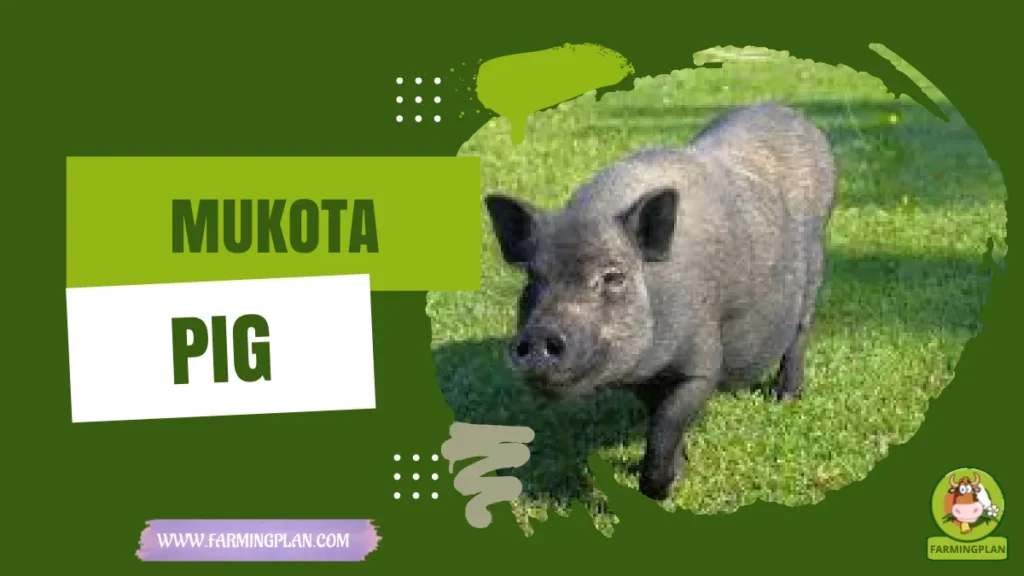If you’re seeking a straightforward, manageable breed that seamlessly integrates into a family farm or homestead, Dexter Cattle could be your perfect match. Recognized for their manageable size, friendly nature, and excellent milk and beef qualities, these animals have swiftly become a favorite among both novice farmers and seasoned breeders. In this article, I’ll guide you through everything I’ve learned about raising Dexter Cattle—from their rich history to health tips, feeding advice, and where to find one for your own land. Whether you’re raising a Dexter calf for the first time or adding another Dexter cow to your herd, you’ll find practical insights straight from the pasture.
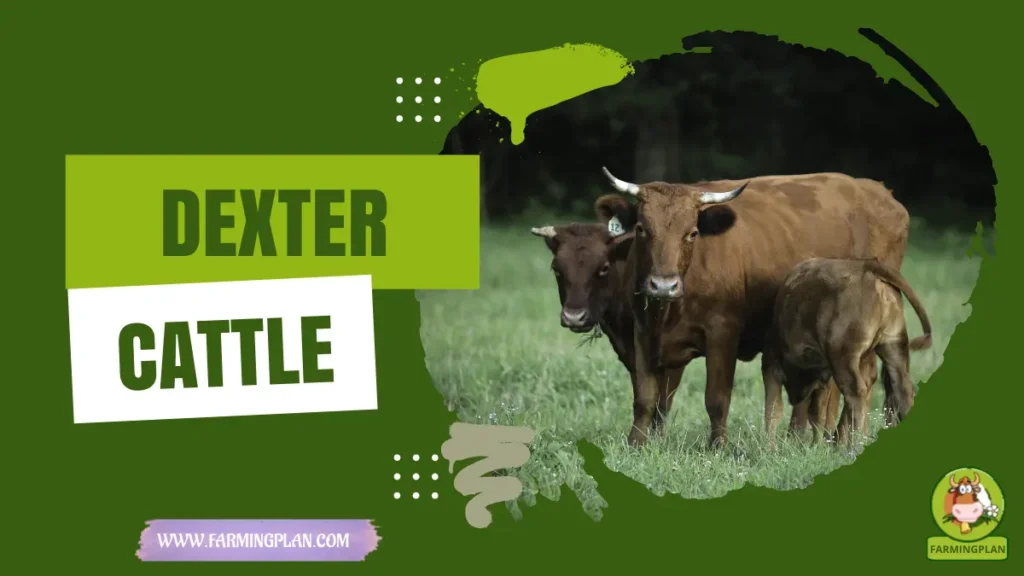
History & Origin of the Dexter Breed
Dexter Cattle trace their origins back to 18th-century Ireland, where they were first developed as a hardy, dual-purpose breed by local farmers in County Kerry. The breed was named after Mr. Dexter, an agent who helped promote them, and their popularity spread across Europe and eventually to North America. As someone deeply connected to heritage breeds, I admire their historical role on small Irish homesteads, where they provided both milk and meat for families with just a few acres of land. This rich history connects Dexter breeders to a tradition that spans centuries and a community of like-minded farmers.
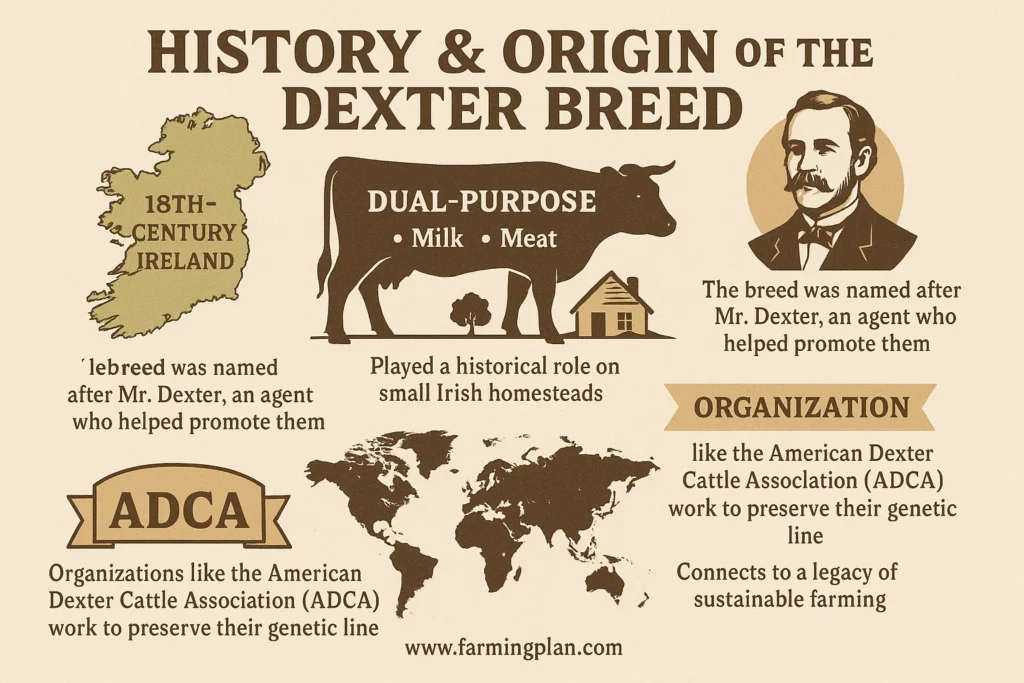
Today, organizations like the American Dexter Cattle Association (ADCA) work to preserve their genetic line. These animals are now registered in herd books managed by the ADCA and similar groups around the world, such as the Dexter Cattle Society in the UK. Their conservation status is a point of pride for many breeders. I often tell new farmers that choosing Dexter Cattle means becoming part of a legacy that supports sustainable, small-scale farming.
Read More: White Park Cattle: A Treasure for Farmers
Characteristics of the Dexter Breed
Dexter Cattle stand out for their compact build and charming appearance. Adults typically measure between 34 to 46 inches at the shoulder. They come in three solid colors—black, red, and dun—with a sleek coat and distinctive, broad head. You’ll find both horned and naturally polled (hornless) types, making them adaptable to different farm setups. What’s great is that they’re sturdy and have fewer calving problems, which makes raising Dexter heifers and bull calves a smoother experience.
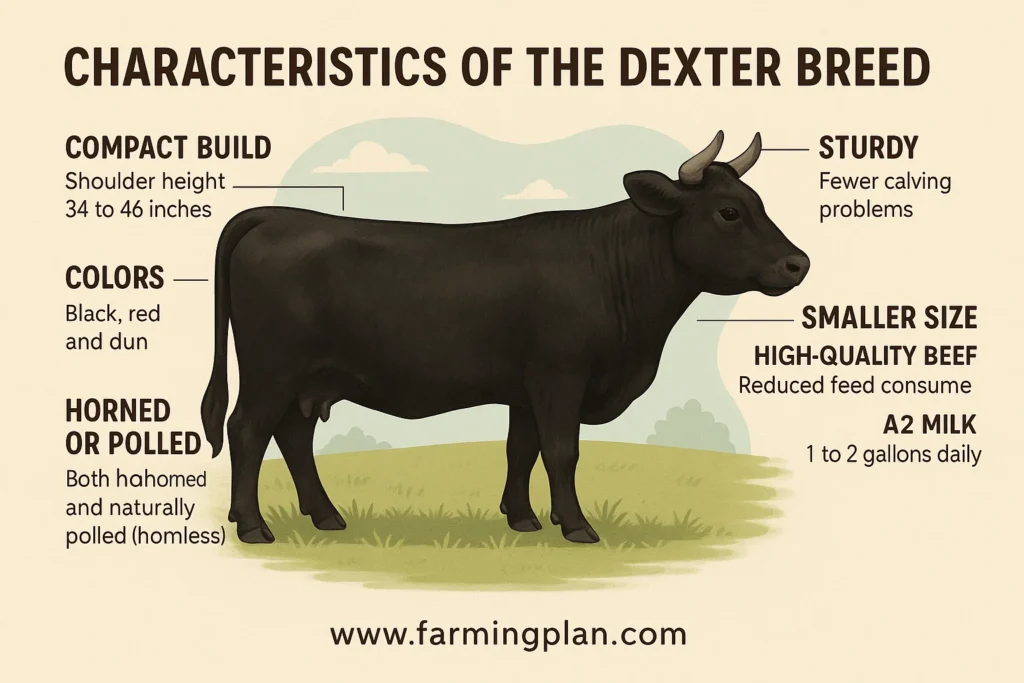
Their smaller size means they consume less feed than larger cattle breeds, yet they still produce high-quality beef and A2 milk. I’ve raised many Dexter steers for meat, and their beef is richly marbled, flavorful, and surprisingly lean. For those focused on milk, a Dexter cow can yield one to two gallons per day, which is ideal for household use. It’s no surprise more folks are looking to buy Dexter cattle for smaller operations.
Read More: Discover the Strength of Santa Gertrudis Cattle: Beef at Its Best
Temperament of the Dexter Breed
What I love most about Dexter Cattle is their temperament. They’re naturally docile, curious, and easy to train—perfect for beginner farmers or families with kids. Dexter calves, in particular, are lively yet manageable, and with early halter training, they become some of the easiest cattle to handle.
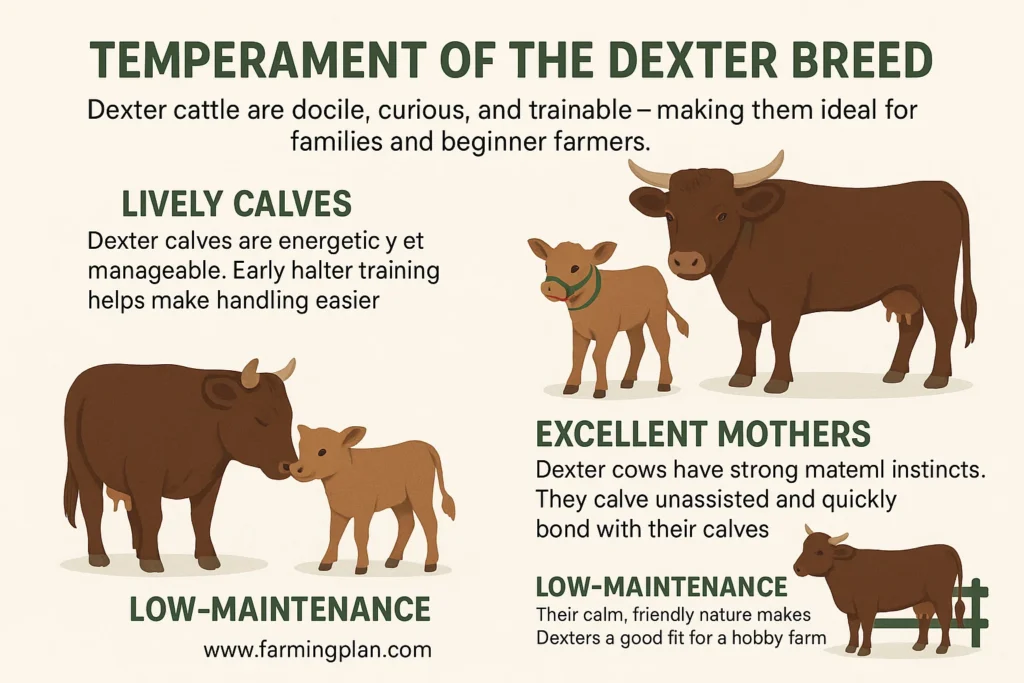
I’ve seen firsthand how their calm nature makes them excellent mothers. Dexter cows are known for their strong maternal instincts. When calving, they often manage without help, and they quickly bond with their calves. This reliability takes a lot of stress out of raising young animals. Whether you’re looking for a low-maintenance cow or a friendly addition to your hobby farm, this breed fits the bill.
Read More: Aberdeen Angus Cattle: A Breed of Excellence
Feeding Dexter Cattle
Feeding Dexter Cattle is simple and affordable, which is another reason I recommend them. They thrive on quality pasture and hay, and their smaller size means they don’t need as much as larger breeds. I typically allow mine to graze freely during the growing season and supplement with hay during winter months. For lactating cows, I add a balanced grain mix and mineral supplements to support milk production. It’s important to avoid overfeeding protein-rich grains, especially to calves, as it can cause growth issues. Always provide clean water and access to a mineral block. A healthy diet goes a long way in ensuring you get quality milk and beef from your Dexter herd.
For lactating cows, I add a balanced grain mix and mineral supplements to support milk production. Avoid overfeeding protein-rich grains, especially to calves, as it can cause growth issues. Always provide clean water and access to a mineral block. A healthy diet goes a long way in ensuring you get quality milk and beef from your Dexter herd.
Uses of Dexter Cattle
Dexter Cattle are truly a dual-purpose breed, equally valuable for their milk and beef. The milk is rich in butterfat—great for making cream and cheese. I often milk my cows by hand, and they produce enough for the household without being overwhelming. Their A2 milk is also easier on the stomach for some people.
When it comes to meat, Dexter steers yield excellent beef in a compact frame. The meat is flavorful and tender. Plus, they mature earlier than many larger breeds, which means faster return on investment. Dexter bulls are also prized for breeding programs focused on creating efficient, grass-fed herds. Whether you’re into dairy, beef, or both, this breed checks all the boxes.
Special Features That Make Dexters Unique
One unique feature of the Dexter breed is their adaptability. They thrive in both cold and warm climates, and they don’t require elaborate infrastructure to flourish. These hardy animals have a long lifespan and excellent fertility. I’ve also observed how well they adapt to rotational grazing, making them ideal for regenerative farm setups. This adaptability ensures that Dexter Cattle can thrive in a variety of farming conditions, providing farmers with peace of mind.
Another unique aspect is their genetic diversity. You can test Dexter Cattle for Chondrodysplasia and Pulmonary Hypoplasia status to avoid affected calves. Most breeders—including me—test for traits like Polled/Horned status, NegPHA, and Chondro status to maintain healthy lines. These distinctions help farmers build resilient herds with clear records and predictable outcomes.
Big Personality In A Small Frame—Dexter Cattle Make Every Acre Count!
Health Issues & How to Keep Your Herd Healthy
Though generally hardy, Dexter Cattle are susceptible to a few genetic conditions. Two you should know about are Chondrodysplasia (a form of dwarfism) and Pulmonary Hypoplasia with Anasarca (PHA). Always buy from reputable breeders who test their animals. I use labs to screen calves before registration, and I recommend checking every animal’s ADCA Reg Number for confirmation. This number can be used to verify the animal’s health status and genetic lineage, ensuring you’re getting a healthy, high-quality animal for your herd.
Basic preventive care goes a long way. Keep hooves trimmed, deworm regularly, and follow a vaccination schedule set by your vet. Clean living conditions reduce risk of parasites or infections. If you’re just starting out, it helps to connect with breeders in networks like the Missouri Dexter Breeders Association for support and advice.
Step-by-Step Farming Guide for Dexter Cattle
Raising Dexter Cattle has been one of the most rewarding parts of my farm life. These hardy, compact cows bring a lot to the table—be it milk, beef, or even companionship. If you’re new to this Irish heritage breed or planning to improve your setup, here’s my complete, hands-on step-by-step guide to raising Dexter Cattle.
Step 1: Plan Your Space and Infrastructure
Dexters don’t need a lot of land, but they do need smart planning. For a small herd, I recommend at least 2–3 acres of good pasture per cow. Make sure your fencing is sturdy—these animals aren’t large, but they’re smart and curious. I prefer high-tensile electric fencing with a minimum of three strands. You’ll also need access to clean water year-round, so install automatic waterers or a reliable trough system.
Provide shelter that blocks wind and rain. A simple three-sided shed works perfectly in most climates. Don’t forget a working pen and a squeeze chute for routine health checks and vaccinations. It saves a lot of stress for both you and the cattle.
Step 2: Choose the Right Dexter Cattle
Whether you’re looking for a Dexter bull, heifer, or steer, source from a reputable breeder. I always check the American Dexter Cattle Association (ADCA) registry for lineage, Chondrodysplasia and Pulmonary Hypoplasia (PHA) status, and whether the cow is polled or horned.
Look for signs of good health: bright eyes, shiny coat, and alert posture. Steers are great for beef; heifers for breeding; bulls for starting your own herd. Keep birth weight, temperament, and maternal history in mind when choosing.
Step 3: Set Up a Proper Feeding Program
Dexters thrive on pasture. My herd grazes most of the year. During winter, I supplement with good-quality hay. Each adult Dexter consumes about 20–25 pounds of hay daily. Offer loose minerals formulated for cattle—salt blocks alone aren’t enough.
Avoid feeding moldy hay or overloading with grain. Dexters don’t need a lot of extra grain unless they’re lactating or being finished for beef. Fresh water access is non-negotiable—keep troughs clean and thawed in freezing temps.
Step 4: Handle Calving and Newborn Care
Dexters are excellent mothers. Calving usually goes smoothly, especially with experienced cows. I keep a close eye during the last few weeks of gestation. Most Dexter calves weigh 25–40 pounds at birth. Once the calf is born, I check that it’s nursing within the first hour.
Tag calves early and start halter-training while they’re small. Trust me—this makes future handling so much easier. Keep the calving area clean and dry to prevent infection. If anything seems off, I always call my vet right away.
Step 5: Monitor Health and Vaccination
Regular health checks are part of my weekly routine. I check body condition, gait, eyes, ears, and manure for signs of illness. Schedule vaccinations with a local vet—common ones include clostridial vaccines and respiratory disease preventatives.
Deworm every season or as needed, based on fecal exams. Watch for symptoms of bloat, scours, or hoof issues. If your Dexter has a Chondrodysplasia or PHA status, work with a vet who understands the breed-specific concerns.
Step 6: Breeding and Herd Management
I usually breed heifers at around 15–18 months, once they reach 65% of their mature weight. Dexters have a 9-month gestation period. Keep a clean and safe breeding area, whether you’re using natural service or AI (artificial insemination).
Keep accurate records for each animal: ADCA registration, vaccination dates, birth details, breeding schedules. Trust me—this information is gold when selling, breeding, or troubleshooting problems.
Step 7: Marketing and Selling Your Dexters
If you’re selling Dexter cattle, register with ADCA or your regional Dexter Cattle Club. Take good pictures, write honest descriptions, and list details like Chondro/PHA status, age, temperament, and milk/beef qualities. Local markets, farm networks, and social media are great for connecting with buyers. Whether it’s a Dexter bull for sale, heifer, or steer, being transparent builds trust and keeps buyers coming back.
Expert Tips and Best Practices
After years with Dexters, I’ve picked up a few habits that keep my herd healthy and productive. First, always record your animals’ pedigree and health test results. It simplifies breeding decisions. Second, rotate grazing areas often. It prevents overgrazing and promotes strong pasture. Connect with local and national groups like the Dexter Club or Dexter Cattle Society to stay updated on best practices. Visiting farms like Jordan Ridge Farm or Blue Glacier Farm has given me valuable ideas too. And never rush to grow your herd—start slow and build with quality over quantity.
Where to Buy Dexter Cattle
To find Dexter cattle for sale, check with the ADCA Breeder Directory. I’ve had great success buying from small farms like Lakeview Dexters, Elmendorf Farm, and Farm Creek Meats. Look for breeders who provide health records, test results, and support. You can also attend local livestock shows and join online groups where Dexter bull for sale or Dexter heifer for sale listings are posted. Always verify the ADCA Reg#, check farm conditions, and never skip a vet check before bringing an animal home.
FAQ
How big do Dexter Cattle get?
Dexter Cattle are small-sized cattle, usually between 34 to 46 inches tall at the shoulder, making them perfect for small farms.
Are Dexter Cattle good milk producers?
Yes! Dexter cows produce 1–2 gallons of high-butterfat milk per day—perfect for family needs or small dairy projects.
Do Dexter Cattle need special care?
They are low-maintenance but do need health checks, vaccinations, and shelter during harsh weather.
What is the average price for a Dexter cow?
Prices vary, but a Dexter cow usually ranges between $1,000 and $2,500 depending on age, registration, and health status.
Can I raise Dexter Cattle on a small farm?
Absolutely! Their small size and low feed requirements make them ideal for farms with just a few acres.
Conclusion
Raising Dexter Cattle has been one of the most rewarding parts of my farming journey. They’re easy to care for, gentle to handle, and produce exceptional milk and meat. Whether you’re starting small or expanding a homestead, Dexters offer a low-stress, high-reward farming experience. If you’re ready to bring one home, just remember: good records, good feed, and good care make all the difference.

